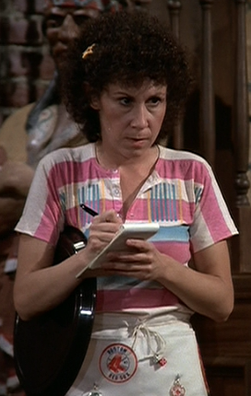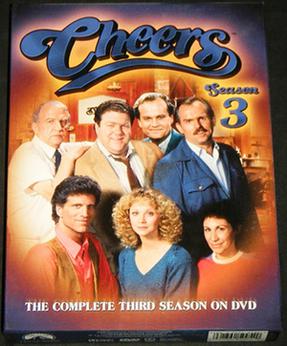
Cheers is an American sitcom television series that ran on NBC from 1982 to 1993, with a total of 275 episodes across eleven seasons. The show was produced by Charles/Burrows/Charles Productions in association with Paramount Network Television and was created by the team of James Burrows and Glen and Les Charles. The show is set in the titular bar in Boston, where a group of locals meet to drink, relax, socialize, and escape from their day to day issues.

Dr. Frasier Winslow Crane is a fictional character who is both a supporting character on the American television sitcom Cheers and the titular protagonist of its spin-off Frasier and the latter’s 2023 sequel. In all three series, he is portrayed by Kelsey Grammer. The character debuted in the Cheers third-season premiere, "Rebound " (1984), as Diane Chambers's love interest, part of the Sam and Diane story arc. Intended to appear for only a few episodes, Grammer's performance in the role was praised by producers, prompting them to expand his role and increase his prominence. Later in Cheers, Frasier marries Lilith Sternin and has a son, Frederick. After Cheers ended, the character moved to a spin-off series, Frasier, through which the span of his overall television appearances totals 20 years. In the spin-off, Frasier moves back to his birthplace, Seattle, after his divorce from Lilith, who retained custody of Frederick in Boston, and is reunited with a newly created family: his estranged father, Martin, and brother, Niles.

Hilary Norman Peterson is a regular fictional character on the American television show Cheers. The character was portrayed by actor George Wendt and is named Hilary after his paternal grandfather.

Carla Maria Victoria Angelina Teresa Apollonia Lozupone Tortelli LeBec, commonly known as Carla Tortelli, is a fictional character in the American television show Cheers, portrayed by Rhea Perlman. Outwardly, at least, Carla is a sarcastic woman who often mocks and makes jabs at others. She had four children with her then-husband Nick when the series started and eight children with three different men when it ended.

Samuel "Mayday" Malone is a fictional character on the American television show Cheers, portrayed by Ted Danson and created by Glen and Les Charles. The protagonist of the series, Sam is a former relief pitcher for the Boston Red Sox baseball team who owns and tends the bar called "Cheers". He is also a recovering alcoholic and a notorious womanizer. Although his celebrity status was short-lived, Sam retains that standing within the confines of Cheers, where he is beloved by the regular patrons. Along with Carla Tortelli and Norm Peterson, he is one of only three characters to appear in all episodes of Cheers. Sam has an on-again, off-again relationship with the bar waitress Diane Chambers for the series' first five seasons until her departure from the series. Then he tries to seduce Diane's replacement, Rebecca Howe, who frequently rejects his advances. Sam also appears in "The Show Where Sam Shows Up", a crossover episode of the spin-off Frasier.

Rebecca Howe is a fictional character of the American television sitcom Cheers, portrayed by Kirstie Alley and created by Glen and Les Charles. Rebecca appeared in 147 episodes of Cheers between 1987 and 1993 and in one episode of Wings. She debuts in the season six episode "Home Is the Sailor" after Shelley Long—who played waitress Diane Chambers—left the show to pursue a movie career. Much of the show's humor in previous seasons had been based around the interaction and sexual tension between the womanizing, working-class main character, bartender Sam Malone, and the high-class, snobbish Diane. Rebecca was intended to fill the gap as Sam's new female foil.
"Give Me a Ring Sometime" is the first episode of the American situation comedy Cheers. Written by Glen and Les Charles and directed by James Burrows, the episode first aired September 30, 1982, on NBC in the contiguous United States and on October 14, 1982 in Alaska. The pilot episode introduces the characters at the Cheers bar in Boston: employees Sam Malone, Diane Chambers, Coach Ernie Pantusso, and Carla Tortelli; and regular customers Norm Peterson and Cliff Clavin. In this episode, Diane, brought in by her fiancé, meets the employees and patrons of the bar. When she realizes that her fiancé has left her alone in the bar, Diane accepts Sam's offer to be the bar's waitress to start over.
"One for the Road" is the final episode of the American television series Cheers. It was the 271st episode of the series and the twenty-sixth episode of the eleventh season of the show. It first aired on NBC on May 20, 1993, to an audience of approximately 42.4 million households in a 98-minute version, making it the second-highest-rated series finale of all time behind the series finale of M*A*S*H and the highest-rated episode of the 1992–1993 television season in the United States. The 98-minute version was rebroadcast on May 23, 1993, and an edited 90-minute version aired on August 19, 1993.

Sam Malone and Diane Chambers, collectively known as Sam and Diane, are fictional characters in the American situation comedy television series Cheers. Sam Malone is a working-class, retired baseball player-turned-bartender played by Ted Danson; Diane Chambers is a college-graduate cocktail waitress played by Shelley Long. Danson appeared on Cheers for its entire run of the series; Long was part of the regular cast from the 1982 series premiere until the fifth-season finale, "I Do, Adieu" (1987). Long returned for a special appearance in the 1993 series finale, "One for the Road."
"I Do, Adieu" is the fifth-season finale of the American television sitcom Cheers, written by Glen and Les Charles and directed by James Burrows. It aired on May 7, 1987, on NBC. During the fifth season, Sam Malone repeatedly proposes to Diane Chambers, and she refuses repeatedly until she accepts engagement in "Chambers vs. Malone" (1987). In the previous episode, "A House Is Not a Home", Sam and Diane bought a house together. Before this episode aired, Ted Danson decided to renew his contract with the show as Sam Malone, while Shelley Long decided to quit the series, which could conclude the on-and-off romance of "Sam and Diane" that went on for the first five years since 1982.
"Home Is the Sailor" is the sixth-season premiere of the American television sitcom Cheers. It originally aired on September 24, 1987, on NBC. It is also the first episode including the fictional character Rebecca Howe, portrayed by Kirstie Alley, as the permanent female lead. It follows "I Do, Adieu", which was Shelley Long's last of her regular appearances as the female lead, Diane Chambers, who also left Boston on the show.
"Coach's Daughter" is the fifth episode of the American television sitcom Cheers, written by Ken Estin and directed by James Burrows. It first aired on NBC on October 28, 1982. This episode guest stars Allyce Beasley as Coach's daughter, Lisa Pantusso. In this episode, Lisa arrives with her fiancé Roy, who is boorish and obnoxious and rude to her, causing Coach to resent him.
"Showdown" is the two-part first-season finale of the American television sitcom Cheers, written by Glen and Les Charles and directed by James Burrows. It originally aired on NBC on March 24 and 31, 1983. In the Cheers pilot, college-educated Diane Chambers was neglected by her previous lover and then hired as a waitress by bartender Sam Malone. Since then, they flirted and resisted each other throughout the season. In this two-part episode Sam's more-successful brother Derek becomes Diane's love interest, leaving Diane torn between Derek and Sam. In the end, Sam and Diane passionately embrace in the office.

The first season of the American television sitcom series Cheers premiered on September 30, 1982, and concluded on March 31, 1983. It consisted of 22 episodes, each running approximately 25 minutes at length. The show was created and produced by director James Burrows and writers Glen and Les Charles, who previously worked on Taxi, another sitcom. Cheers was produced by Charles Burrows Charles Productions in association with Paramount Television. The concept and production design of the show were inspired by a public house in Boston, the Bull & Finch, which is now called Cheers Beacon Hill.

The second season of Cheers, an American situation comedy television series, originally aired on NBC in the United States between September 29, 1983, and May 10, 1984, with 22 episodes. The show was created by director James Burrows and writers Glen and Les Charles and was produced by Charles Burrows Charles Productions in association with Paramount Television. The second season has been released on DVD as a four-disc set.

The third season of Cheers, an American television sitcom, originally aired on NBC in the United States between September 27, 1984, and May 9, 1985. The show was created by director James Burrows and writers Glen and Les Charles under production team Charles Burrows Charles Productions in association with Paramount Television. The third season is available on DVD in a four-disc set.

The fourth season of Cheers, an American television sitcom, originally aired on NBC in the United States between September 26, 1985, and May 15, 1986, as part of the network's Thursday lineup. This season marks Woody Harrelson's television debut as Woody Boyd after Nicholas Colasanto, who portrayed Coach Ernie Pantusso, died during the previous season. The show was created by director James Burrows and writers Glen and Les Charles, under production team Charles Burrows Charles Productions, in association with Paramount Television.

The fifth season of Cheers, an American television sitcom, originally aired on NBC in the United States between September 25, 1986, and May 7, 1987. This season marks the departure of Shelley Long as Diane Chambers, bringing an end to the Sam and Diane relationship. The show was created by director James Burrows and writers Glen and Les Charles, in association with Paramount Television.

The sixth season of Cheers is an American television situation comedy set in a Boston bar called "Cheers". It originally aired on NBC in the United States between September 24, 1987 and May 7, 1988. The show was created by director James Burrows and writers Glen and Les Charles under their production company Charles Burrows Charles Productions, in association with Paramount Television. This season features the debut of Kirstie Alley as Rebecca Howe.













